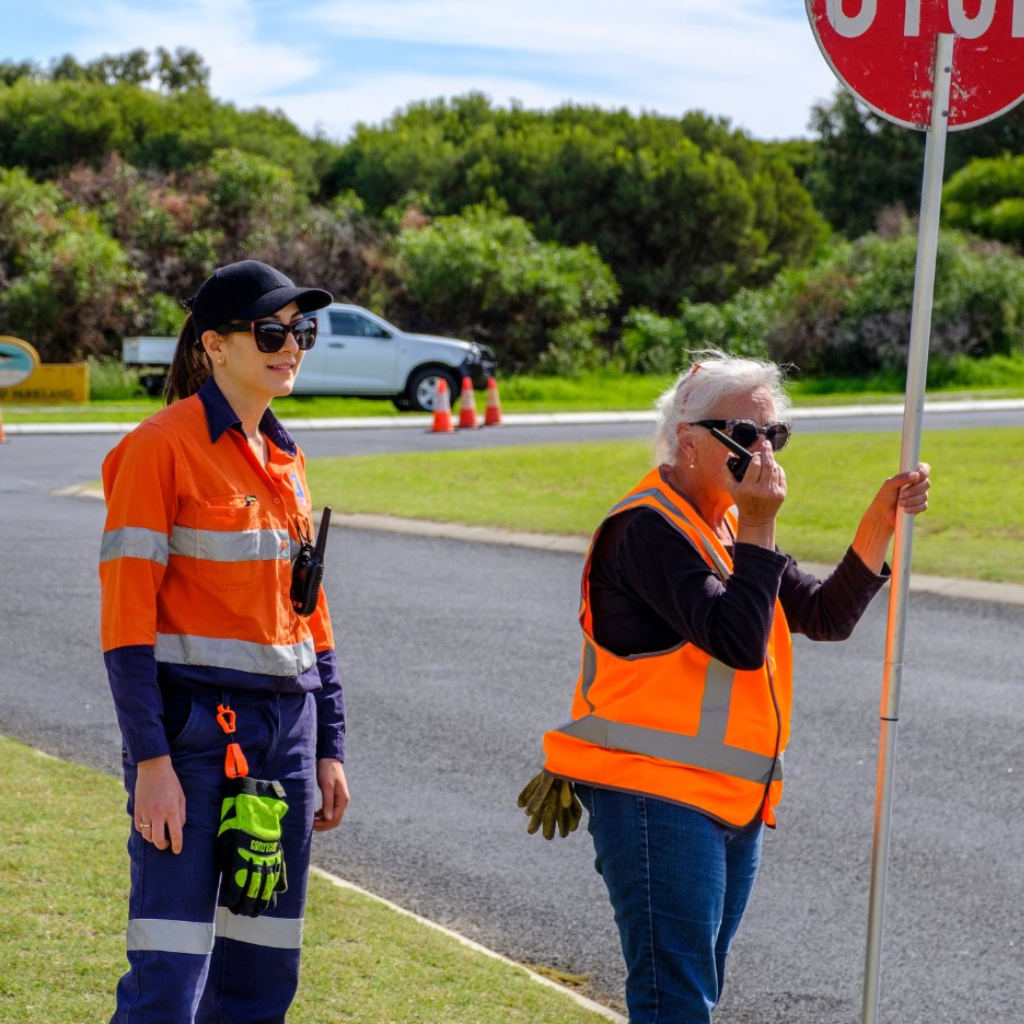Main Roads WA has released a NEW Code of Practice for Works on Roads September 2023. We’ve put together a helpful article that summarises the key changes from this update so you can stay across all the current changes.
If you and your organisation work on or near roads, then this is a must-read for you. The following key changes have been updated;
6.3 Securing Signs & Devices
6.3.1 Securing Signs
AS 1742.3 indicates that signs and devices must be positioned and erected so that they are properly displayed and securely mounted. The mountings must also be stable in windy conditions and from the effects of moving traffic. Signs must have additional sign support and be located with adequate lateral clearance from the travelled way.
Scenarios more likely to encounter fallen signs include but not limited to:
- Windy conditions are expected; or
- The road will be used by road trains, or
- The permanent speed is 80 km/h or greater.
Signs must be mounted on permanent posts* where required at that location for more than 14 days, where permanent posts are proposed not to be used, a risk assessment by an RTM must first be undertaken to detail why they are not being installed and provide mitigation such as regular maintenance arrangements or additional supports.
At locations where signs are not mounted on permanent posts, and the works are not considered Short Term Low Impact, the signs must be securely mounted. This may include one of the following methods:
- Sandbags (or similar) on all 4 legs (total weight of at least 40kg)
- Affixing to other suitable permanent roadside infrastructure **
- Semi-permanent mounting of permanent posts (in accordance with manufacturers specifications e.g. Oz Spike or similar
The following options must also be considered, to further mitigate the risk if signs do fall over
- Regular monitoring and maintenance in place to rectify fallen signs
- Use of Portable Variable Message Signs in advance of the work site
There may be a need to use a combination of the above methods on any particular site and some form of monitoring will always be required. For example, use of permanent posts for the ROADWORK AHEAD and initial speed reduction signs required for the entire duration of the project but temporary sign legs for the traffic control warning signs that need to be removed and/or relocated throughout the works.
If a sign has fallen over, measures must be taken to stop this from reoccurring. This may include weighing down the legs, safely fastening the device to suitable objects or post mounting the sign.
Note: Project / Contract Managers should ensure the above is considered in contract documentation, ensuring appropriate resources and personnel are provided for the required method of installation and monitoring.
* Permanent posts and mounting in accordance with Main Roads specification 601
** Signs must not be affixed to road safety barriers. If affixing to permanent sign posts ensure the permanent sign is covered or removed if required.
5.2 Traffic Management Operation & Records
It is a requirement that any party undertaking work on or alongside a road, must keep a copy of the current approved TMP onsite. Daily records of the sign arrangement or traffic guidance scheme must be kept in a diary in accordance with AGTTM Part 6: Field Staff – Implementation. As a minimum, the Daily Diary must be based on the Daily Diary Template on the Main Roads website www.mainroads.wa.gov.au; go to Technical & Commercial’ > ‘Working on Roads’
Due to the availability of smart phones and video cameras, when conducting workplace inspections and/or altering the traffic guidance scheme, video evidence should be considered (to support written documented records).
As of 1 January 2025, any organisation implementing temporary traffic management on a Main Roads worksite must conduct video drive throughs (using a Dash Cam or similar) as per the inspection schedule, to record the implemented traffic guidance scheme. This video* must be stored for a period of 7 days and provided to Main Roads when or if requested. This does not apply to Short Term Low Impact works as per AGTTM Part 5 or Mobile Works as per AGTTM Part 4.
Claims for damages are often made a considerable time after an incident. Under the Limitation Act (WA), claims for negligence must be commenced within six (6) years. However, a defendant may be unaware that an action has commenced for a further year as the plaintiff has this time in which to serve the writ.
Main Roads recommends that traffic management records be securely stored for a period of not less than seven (7) years from the date of completion of the works. The Authorised Body that grants approval to a Traffic Management Plan should keep a copy of the approved Traffic Management Plan and any daily records of their supervisory staff that capture the on-going implementation of the Traffic Management Plan.
In case of all works undertaken for or on behalf of Main Roads, the persons arranging the traffic management works must keep their own daily records in addition to a copy of the approved TMP together with any other relevant records.
For all other works the requirements for record keeping in relation to traffic management must be determined by the Authorised Body responsible for or authorising the work.
* Video to have a frame rate of at least 3 frames per second (FPS)
2.1.2 Traffic Management Company Registration Scheme
The Traffic Management Company Registration Scheme applies to all parties, including local governments and Authorised Bodies that implement lane / road closure or speed restriction on State roads. This applies to all State roads across Western Australia. The guidelines including contact details and the application kit are available on Main Roads website at www.mainroads.wa.gov.au ; go to ‘Technical and Commercial’ > ‘Working on roads’ > ‘Traffic Management Company Registration Scheme’.
Traffic management sites involving ‘complex traffic arrangements’ on Main Roads controlled roads, must have at least one person with either a Worksite Traffic Management (WTM) or Advanced Worksite Traffic Management (AWTM) accreditation.
A Worksite Traffic Management (WTM) accredited person on-site at all times when road workers are present.
As of 1 January 2025, any organisation implementing temporary traffic management on a Main Roads worksite must conduct video drive throughs. Refer to section 5.2.
Refer to the Austroads website for details on the Austroads Traffic Management Prequalification Scheme. Go to www.austroads.com.au > ‘Network and Freight’ > ‘Temporary Traffic Management.’ When available, details on the Main Roads adoption and transition will be provided on the Traffic Management Registration page of the Main Roads website.
What Do I Need To Do?
As a result of the above changes, here are some recommended actions or steps to take;
- Make sure you are a subscriber to our mailing list – that way you will receive this and any future updates direct to your mailbox. To sign up click here.
- Download and read the latest Main Roads WA Code of Practice Works on Road. Please note there are other changes not summarised in this article, therefore it is important you read the full updated document.
- Inform your organisation and co-workers about these new changes.
- Review your workplace policies, procedures and other documents that may be impacted. Schedule time to update workplace documents and convey these changes to your team.
If you would like to read the earlier Main Roads WA Code of Practice key changes from March and May 2023 – click here
Got Questions?
Do you have any questions and need further assistance with any part of the expected new Main Roads WA Code of Practice for Works on Roads? Get in touch and contact us.
Do you need training?
Do you need temporary traffic management training for your team? We have a wide range of public training course’s view calendar here or our team can travel to your workplace for onsite training request a quote here.


